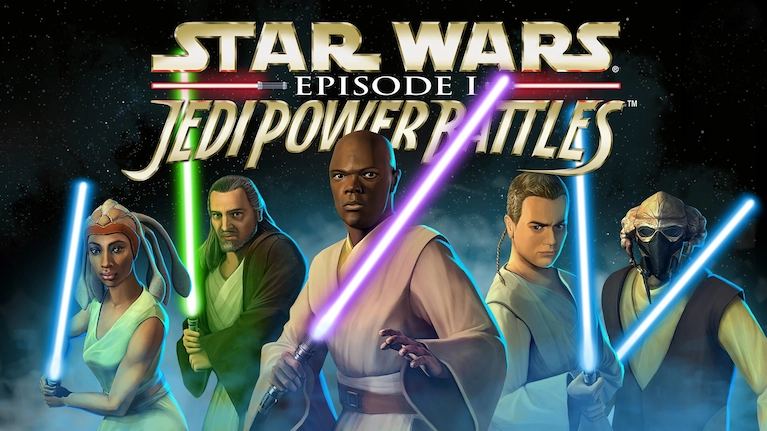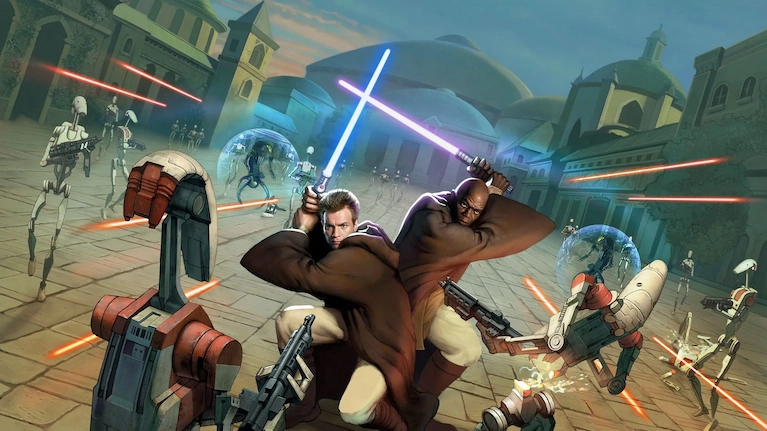The Star Wars franchise is one of the rare cultural phenomena that has made history both on the big screen and in the world of video games. From classic arcade games in the ’80s to modern hits like Jedi: Survivor, the galaxy far, far away has always held a special place in the hearts of gamers. When The Phantom Menace debuted in the late ’90s after years of cinematic silence, it brought with it a wave of tie-in merchandise—including a string of video games that sought to expand George Lucas’s epic universe. Among them was Star Wars Episode I: Jedi Power Battles, a title that became somewhat of a cult classic despite its flaws.
Now, 25 years later, developer Aspyr has brought the game back to life with a remastered version for modern consoles. But the question remains: is this return a worthy celebration of the original, or just another cash-in on nostalgia?
A Jedi Experience Before Its Time
For many fans, Jedi Power Battles was their first real experience of becoming a Jedi in a video game. Long before Jedi: Fallen Order or The Force Unleashed, this game gave players the chance to wield lightsabers in different colors, battle through familiar movie locations, and step into the boots of iconic Jedi characters.
The remaster aims to rekindle those memories, keeping the same gameplay while offering visual upgrades and a few new features. But does it succeed?
Core Gameplay: Hack, Slash, Repeat

Jedi Power Battles is a 3D beat ’em up with platforming elements and a touch of hack & slash. The game follows a linear level structure, inspired by The Phantom Menace, and includes missions like rescuing allies, fighting off waves of enemies, and confronting bosses like Darth Maul.
Gameplay is simple and old-school: defeat enemies, move forward, earn points, and occasionally upgrade your character. While fun in short bursts, it lacks depth and quickly becomes repetitive.
New Features in the Remaster
The remastered edition offers a few welcome improvements. All of the original unlockable characters are now available from the start, including Qui-Gon Jinn, Obi-Wan Kenobi, Mace Windu, Darth Maul, Queen Amidala, Captain Panaka, and Ki-Adi-Mundi. The Dreamcast-exclusive characters also return, along with a few new additions that can be unlocked by finishing the game or using cheat codes.
One notable absence is Yoda, who wasn’t included in the original game. At the time, Yoda’s fighting style hadn’t been shown on screen, making his omission more understandable. Still, in today’s context, his absence feels odd—though perhaps a blessing given the game’s sluggish combat.
Combat That Feels Outdated
While deflecting blaster bolts with your lightsaber is satisfying, the rest of the combat feels stiff and underwhelming. Lightsaber attacks have noticeable input delays, combos rarely flow smoothly, and enemy AI behaves erratically. Rather than delivering the empowering feel of a Jedi master, the combat ends up feeling repetitive and clunky.
The biggest letdown is how The Force is implemented. Each Jedi has three Force abilities—a ranged attack, a melee move, and a defensive skill. Unfortunately, most of them are unbalanced, poorly explained, or downright broken. Inexplicably, characters like Darth Maul shoot lasers from their eyes, while Qui-Gon Jinn’s defensive move barely works. These mechanics often feel out of place in the Star Wars universe.
Visuals and Performance: A Minimal Upgrade
Graphically, this remaster plays it safe. While textures are sharper, the 3D models still look blocky, and the environments are barren and lifeless. Iconic locations like Theed and Coruscant haven’t seen significant improvements and still feel like they belong to a previous console generation.
Aspyr has made minor platforming improvements, with jumps now feeling slightly more accurate, but many of the original game’s limitations remain. Players may still get stuck on ledges or fall due to awkward collisions—reminding us that this is more of an enhanced port than a full remaster.
Cutscenes and Sound Design: Stuck in the Past
One of the most disappointing aspects is the cutscenes. Unlike modern remasters that recreate or upscale cinematic moments, Jedi Power Battles Remaster keeps the old, blurry pre-rendered videos, which look jarring on high-resolution displays.
Sound effects are also dated. While The Phantom Menace’s music returns, it’s repetitive and occasionally cuts off abruptly. Voice lines are inconsistent and some dialogues don’t trigger properly, further hurting immersion.
A Few Bright Spots
If there’s one area where the remaster succeeds, it’s in preserving the original cheat codes. From the classic Big Head Mode to colorful lightsabers, fans can still enjoy the quirky charm of the original game. However, aside from these nostalgic extras, no major new content has been added.
Final Verdict: A Remaster Too Loyal to the Original
The biggest flaw of Jedi Power Battles Remaster is that it remains too faithful to the original. While remasters like Tomb Raider I–III updated both visuals and mechanics, Aspyr chose to leave this game largely untouched—and it shows.
If you played and loved the original back in 2000, this version may rekindle fond memories. But if you expected a modernized remaster with revamped graphics, improved controls, or added features like online co-op, you’ll likely be disappointed.
Aspyr missed an opportunity to transform a cult classic into something greater. A true remake, rather than a basic visual update, is what this game really needed.
Should You Play Jedi Power Battles Remaster in 2025?
If you’re a die-hard Star Wars fan and want to experience some local co-op lightsaber action with a friend, this might still be a fun retro throwback. But for modern audiences used to polished gameplay and cinematic presentation, Jedi Power Battles Remaster is a relic best approached with tempered expectations.
